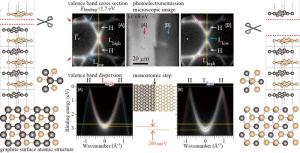Researchers from the Institute for Molecular Science in Okazaki, strive to understand the electronic structure of graphite by analysing its surface state using a newly developed photoelectron spectroscopy machine combined with an electron microscope.
Graphite is an incredibly important, versatile mineral, with uses spanning across many different industries. Because graphite can easily conduct electricity and withstand high temperatures, it is especially important for electronics. Graphite is an essential component of lithium-ion batteries, and demand is only increasing as new technology is developed. For example, solar power and electronic vehicles will require increased production of batteries and the need for graphite will continue to increase.
Even though graphite has been thoroughly researched for decades, there is still more for researchers to uncover. Surprisingly, spectroscopic studies have yet to accurately measure the electronic states of the surface and the edge of graphite from a microscopic point of view. This is important because the improvement in battery performance depends largely on the control of the characteristics of the graphite at the tip.
In a paper published on 21 June 2022 in Physical Review B, researchers have detailed new observations of the surface state of graphite using a newly developed photoelectron spectroscopy machine combined with an electron microscope.
Analysing the electronic structure of graphite
“In this study, we report the microscopic observation of three-fold symmetric graphite surface states coupled with bulk kz dispersed π bands. The findings highlight the relevance of considering surface effects in bulk intrinsic electronic state measurements,” said Fumihiko Matsui, a Professor at Institute for Molecular Science in Okazaki, Japan. “The question we address is: how accurate can we measure the intrinsic bulk kz dispersion?”
Crystalline structures such as graphite have energy bands in what is known as a band structure. In addition to the inherent bulk band structure, there is a special electronic structure on the surface of the material, which is called the surface state. Macroscopic measurements tend to fail to recognise the various fine structures on the surface.

Photoelectron momentum-resolved spectro-microscopy
In the worst case, this conventional measurement technique can lead to ignoring surface states and misinterpretation of bulk-specific electronic properties. Using a technique called photoelectron momentum-resolved spectro-microscopy, researchers examined the electronic structures of graphite’s surface. Through this, they were able to see how the surface states interacted with the bulk bands and succeeded in imaging single-atom height steps on a graphite surface. Understanding both the surface state and band structures of graphite can help researchers understand its electrical properties as well.
Graphite is a crystalline form of carbon that is made up of many layers. Each individual layer of graphite, called graphene, is structured in a hexagonal honeycomb. The way these layers stack on top of each other affects the type of electronic band structures that are found in the graphite.
“Graphite crystals with an ABAB-type stacking structure are six-fold symmetric around the z-axis, whereas a surface with one type of termination is three-fold symmetric,” explained Matsui. When researchers looked at the dispersion of the kz band at the micrometre-scale, they discovered that the combination of this six-fold structure and the three-fold structure eliminated the degeneracy of the π band and the symmetry was reduced.
Graphite surface geometry with broken symmetry
“In this study, we have succeeded in characterising the effect of such a coupling in a surface geometry with broken symmetry,” said Matsui. “The observed bulk dispersion differs from the discrete electronic states of several layers of graphene, meaning that the measurement is also sensitive to the bulk electronic states from much deeper than the mean free path length of the emitted electrons. Moreover, the kz dispersion bandwidth is affected by the coupling with the surface electronic state, as shown in this study. The accuracy and resolution of kz dispersion bandwidth determination are limited by the electron attenuation length, especially when the surface resonance state couples with the bulk kz–dispersed band.”
Looking ahead, more theoretical research is required to understand how these different structures work together. “Further theoretical studies of valence photoelectron emission with precise consideration of the surface effect are desired in order to clarify the kz intensity dependence,” concluded Matsui.





